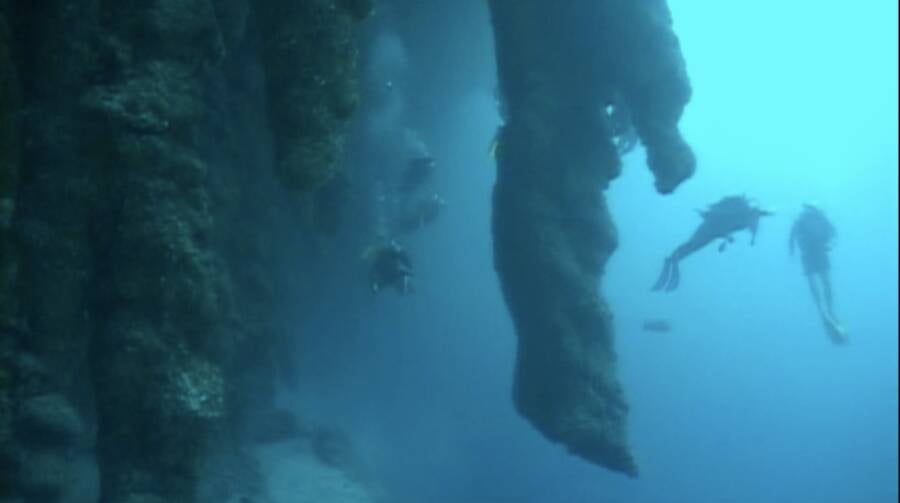The Great Blue Hole is one of the world's top scuba destinations — but it's also led some unfortunate divers to their deaths.

Wikimedia CommonsThe Great Blue Hole near Belize is the largest underwater feature of its kind.
About 43 miles off the coast of Belize City, Belize sits an extraordinary natural marvel known as the Great Blue Hole. A massive sunken underwater cave, the Blue Hole’s crystal clear waters, diverse marine life, and stunning geological formations have made it one of the world’s top scuba diving destinations.
Viewed from above, the sinkhole looks like a circle of the deepest blue surrounded by rings of turquoise, aquamarine, and cerulean. In fact, this color contrast is so dramatic that the Great Blue Hole can be seen from space.
Dive into the fascinating history of the Great Blue Hole and the eerie secrets explorers have uncovered in its depths.
The Great Blue Hole: A Scuba Diver’s Paradise

Wikimedia CommonsLighthouse Reef Atoll as seen from space. The Great Blue Hole is near the center of the image.
The Great Blue Hole is part of the Barrier Reef Reserve System, a UNESCO World Heritage Site. According to Belize’s tourism website, it’s the largest known naturally occurring underwater sinkhole, at 984 feet across and 410 feet deep.
The Blue Hole is located in the center of Lighthouse Reef, which is an atoll or a ring of coral with a lagoon at its center. Overhead photos of the sinkhole reveal a near-perfect circle of deep blue outlined in the lighter greens and blues of the atoll.
Divers who visit the Great Blue Hole can explore underwater caves and see stunning formations like stalactites and stalagmites, some of which are 30 to 40 feet tall. As you swim through the sinkhole’s incredible coral reefs and interconnected caverns, you may come across tropical fish, nurse sharks, and giant groupers.
The Great Blue Hole isn’t only for scuba divers, though. Anyone interested in visiting can take a boat to Lighthouse Reef and snorkel near its surface.
Because this is an incredibly technical dive that requires scuba divers to descend as deep as 135 feet, however, not everyone is allowed to enter the Great Blue Hole. Only certified divers who have completed more than 24 dives can book tours into the depths of this underwater cave system or plan their own exploration.
How Was The Great Blue Hole Formed?

Aquatica SubmarinesStalactites in the Great Blue Hole hint at its past life as a limestone cave above the ocean’s surface.
The Great Blue Hole is believed to have originally been a limestone cave that formed during the last Ice Age.
Around 70 million years ago, giant fault blocks settled in step-like platforms on the Earth’s surface, creating vast limestone ridges that formed platforms on which coral could form. After the last Ice Age, the sea level gradually rose above these platforms. The coral continued to grow, creating the ring-shaped walls of Lighthouse Reef Atoll.
Meanwhile, the rising sea levels also caused the limestone caverns at the center of this coral formation to flood with water. The pressure eventually caused the cave to collapse, forming the vast sinkhole now known as the Great Blue Hole.
“It was the deepest, deep blue hole imaginable; a chasm that fell away deep into the deep, dark blue. It had been forged out of solid rock as caverns,” said NASA scientist Glyn Collinson after exploring the cave system.
“For eons, water filtered through the rock and into these great stone cathedrals, breeding multicolored stalactites and stalagmites,” Collinson continued. “Then, one by one they collapsed in on each other, creating a chasm four hundred feet deep. As Earth’s swollen polar ice-caps receded, the warm Caribbean ocean swept in to fill the chasm with boiling white hands, the last rays of sunlight struck the chasm’s floor. Then, as the limestone broke down, it began to rain tiny fragments of rock, which slowly began to fill the Great Blue Hole.”
But although this natural landmark dates back to prehistoric times, its history as a diving destination is much more recent.
The Great Blue Hole Becomes A Diving Destination
Few records exist of humans using the Great Blue Hole before the 16th century, though the earliest archaeological evidence suggests the ancient Maya lived on Belize’s atolls for hundreds of years.
Then, from 1528 to 1532, Spanish explorers traveled through the atolls and began charting and researching them. Documents from later in the 16th century indicate that the Spanish called Lighthouse Reef Quattro Cayas (Four Keys) or Eastern Reef. It wasn’t until the English occupied the area in the 1750s that the atoll was renamed Lighthouse Reef after a nearby lighthouse.
Still, the Great Blue Hole itself remained largely unexplored. Then, in 1971, the famed diver and oceanographer Jacques Cousteau arrived in the area on the RV Calypso. He filmed his dive into the sinkhole for his show The Undersea World of Jacques Cousteau.
Cousteau immediately became enchanted with the Blue Hole’s underwater caverns and an array of marine life, and he declared it one of the top 10 diving destinations in the world. As Cousteau was considered the leading authority on underwater exploration at the time, this accreditation helped make the Great Blue Hole a popular diving spot.
While exploring the sinkhole’s cavern systems, Cousteau also came across its massive stalactites, noting that they were an unusual sight because stalactites usually only appear on the ceilings of caves on land. Later, an analysis of the formations confirmed that the cave once stood above sea level.
The Great Blue Hole was officially given its name years later by British diver Ned Middleton in his 1988 book Ten Years Underwater. He explained that he’d chosen the name because he wanted to associate Belize’s reef system with Australia’s Great Barrier Reef.
But future explorations of the Great Blue Hole would reveal just how little we know about it.
Recent Expeditions Reveal More Of The Blue Hole’s Secrets

Aquatica Submarines/Thomas Bodhi WadeA submarine explores the depths of the Great Blue Hole.
In 2018, Jacques Cousteau’s grandson, Fabien Cousteau, joined British billionaire Sir Richard Branson and oceanographer Erika Bergman on a submersible expedition to the bottom of the Great Blue Hole. Their mission was to digitally map the entire sinkhole, taking high-quality photos and videos of the cavern system.
While there, they came across a puzzling find: a series of tracks of unknown origin.
“There were… these odd tracks, crisscrossing circles right around the center of the hole with no indication of what had made them,” Bergman told Newsweek.
In another chilling discovery, they also came across the remains of two divers who had died while exploring the Great Blue Hole. Their bodies were found beneath a hydrogen sulfide layer that lies 290 feet beneath the surface. Because there’s no oxygen below this toxic gas layer, anything that falls beneath it is shockingly preserved. Indeed, the unidentified bodies had been mummified.
Deciding the divers were “at peace,” the team left their bodies undisturbed. They presumably still sit at the bottom of the hole to this day.
The team also found a graveyard of hundreds of dead conches that had likewise fallen beneath the hydrogen sulfide layer, as well as a few plastic bottles. Still, as Bergman told CNN, the sinkhole remains mostly untouched by humans.
“It’s neat that there are spaces on our planet — and most of them in the oceans — that are exactly the way they were thousands of years ago and will remain exactly the way they are thousands of years in the future,” Bergman said.
With so little known about the bottom of the ocean, the Great Blue Hole surely has more secrets hidden in its depths, just waiting to be discovered.
After reading about the Great Blue Hole in the Caribbean, explore Jacob’s Well, one of Earth’s most treacherous diving spots. Then, read about five other fascinating sinkholes around the world.






